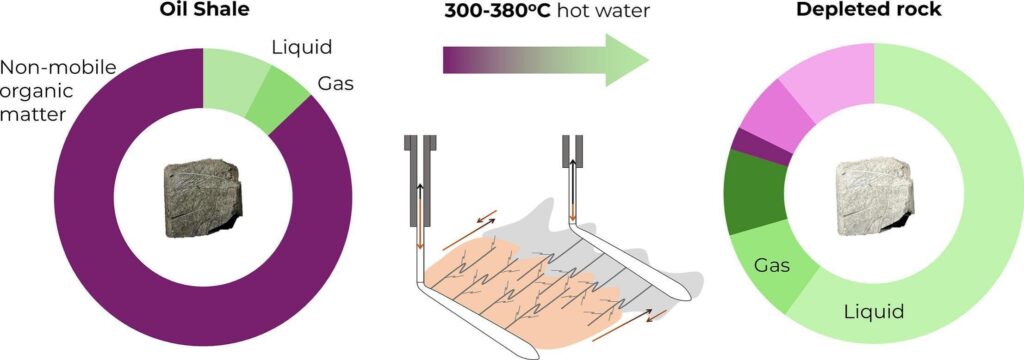
In the culmination of a seven-year R&D project commissioned by a major oil company, a team of Skoltech researchers has published a study in the Chemical Engineering Journal, presenting an advanced method for enhanced oil recovery from kerogen-rich oil shale.
This refers to a type of oil deposits that are notoriously difficult to develop and yet are known to exist in Russia, the United States, China, and South America. The research draws on the results of extensive experiments on rock samples and is ready for industrial tests.
Kerogen-rich shale is a type of oil-bearing rock containing a lot of solid organic matter—called kerogen—that has not matured into oil yet. Such rock is characterized by extremely low porosity and permeability. With conventional methods, it will not be ready to extract from for many millions of years.
Even if enhanced oil recovery is used, which may include injecting carbon dioxide into the rock, the result is that some of the oil trapped within can be released, but kerogen itself stays in place and is usually not even considered in the oil content calculations.
“We have devised and tested a way to artificially convert kerogen into oil underground and release it by pumping very hot water, technically called supercritical, into the rock at 200 to 300 times the normal atmospheric pressure,” said the study’s lead author, Leading Research Scientist Elena Mukhina from Skoltech Petroleum.
“In our experiment with an 18-kilogram, 180-centimeter rock model, which did not contain any mobile oil to begin with but did contain 10–15% kerogen by mass, almost all of that kerogen was converted into oil and extracted. Conventionally, that oil would not even figure in the calculations. Meanwhile, rock porosity increased from 0.1% to about 30%.”

The meticulous experiment, which concluded a long series of tests run over the course of the seven-year industrial project, lasted for an uninterrupted 10 days, with laboratory personnel working in shifts to continually monitor the equipment and collect the oil filtering out of the rock.
The experiment showed that the temperature of the water when it reaches its destination underground should be above 350 degrees Celsius. That enables the kerogen-to-oil conversion, which naturally happens at 100 C over millions of years, to be accelerated to mere hours—including the time it will take to recover the oil.
The next question then is how to deliver the hot water to 3 kilometers underground and how to get the oil out. With low-permeability reservoirs, a horizontal borehole is usually drilled and hydraulic fracturing is performed. That involves cracking the rock around the well with pressurized water loaded with chemicals.
To enhance oil recovery, the horizontal borehole is repeatedly injected with fluid and/or gas, such as CO2, followed by oil extraction. Then the cycle repeats. That standard “huff-and-puff” approach would work with supercritical water injection, too, but it turns out there is an even better option.

“With a single borehole, a large portion of the water is lost after each injection and drives some of the synthesized oil away from the well. We propose that two boreholes be drilled parallel to each other in a horizontal plane, one of them for fluid injection and the other for extracting oil.
“As we have shown, our patented double-borehole approach is both economically feasible and less taxing on the environment. The equipment for generating supercritical water runs on highly purified water, so this rules out the use of chemicals for enhanced recovery.
“Also, after the water is injected into a separate borehole, it can be recovered from the other borehole, purified, and reused over and over, conserving many tons of that precious resource. At some point, the roles of the two boreholes can be reversed.”
According to the researchers, their technique for extraction is currently being cleared for field tests by a major industrial partner of the Institute.
More information:
Elena Mukhina et al, Sustainable hydrocarbon recovery from immature organic-rich shales: Large-scale thermal experiment and field application, Chemical Engineering Journal (2025). DOI: 10.1016/j.cej.2025.162713
Skolkovo Institute of Science and Technology
Citation:
Lab test supports method to synthesize extractable oil from solid organic matter locked 3 km underground (2025, June 16)
retrieved 16 June 2025
from https://techxplore.com/news/2025-06-lab-method-oil-solid-km.html
This document is subject to copyright. Apart from any fair dealing for the purpose of private study or research, no
part may be reproduced without the written permission. The content is provided for information purposes only.

